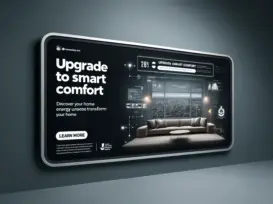Grus Home Energy - Central Air Conditioning Thermostat
Maximizing Comfort with a Central Air Conditioning Thermostat
Central air conditioning thermostats play a crucial role in keeping your home comfortable and energy-efficient. By setting the thermostat correctly, you can maintain a consistent indoor temperature while also saving on energy costs. Here are some tips on how to maximize comfort with a central air conditioning thermostat:
1. Choose the Right Thermostat:
When selecting a central air conditioning thermostat, consider the features that are important to you. Programmable thermostats allow you to set different temperatures for various times of the day, helping you save on energy costs. Smart thermostats can be controlled remotely through your smartphone, giving you greater flexibility and convenience.
2. Set the Temperature Correctly:
For optimal comfort and energy efficiency, the U.S. Department of Energy recommends setting your thermostat to 78°F (25.5°C) when you are at home and need cooling. When you are away or asleep, consider raising the temperature by a few degrees to save on energy costs. Avoid setting the thermostat to extremely low temperatures, as this can lead to higher energy bills.
3. Use Programming Features:
If you have a programmable thermostat, take advantage of its features to create a cooling schedule that fits your lifestyle. Program the thermostat to raise the temperature when you are away at work or asleep, and lower it before you return home or wake up. This way, you can enjoy a comfortable indoor environment without wasting energy when no one is home.
4. Maintain Your Thermostat:
To ensure your central air conditioning thermostat operates efficiently, it is essential to perform regular maintenance. Check the batteries periodically to ensure they are functioning properly. Clean the thermostat with a soft cloth to remove any dirt or dust that may affect its performance. If you notice any issues or inconsistencies with the thermostat, contact a professional HVAC technician for assistance.
5. Consider Zoning Systems:
If you have a large home with multiple floors or rooms that differ in temperature, consider installing a zoning system with separate thermostats for each zone. This allows you to control the temperature in specific areas of your home, providing personalized comfort and energy savings. Zoning systems can be especially beneficial for homes with varying heating and cooling needs.
6. Utilize Energy-Saving Features:
Many central air conditioning thermostats come with energy-saving features, such as vacation mode or adaptive recovery, which help reduce energy consumption. Vacation mode allows you to set the thermostat to a higher temperature when you are away for an extended period, while adaptive recovery learns how long it takes to reach your desired temperature and adjusts accordingly to prevent energy waste.
By following these tips and utilizing the features of your central air conditioning thermostat, you can maximize comfort in your home while also saving on energy costs. Remember to consult your HVAC technician for guidance on selecting the right thermostat and optimizing its performance for your specific needs.
Blog, Energy & Electricity Basics , April 24, 2024 , Central Air Conditioning Thermostat, Electric Heating Thermostat, Fresh Air Thermostat, Heat Pump Thermostat, Home Thermostat, Smart Thermostats, Solar Water Heater Thermostat, Thermostat, Thermostat Type, Thermostats Types, Underfloor Heating Thermostat, Water Heater Thermostat
©2025 All Rights Reserved. Grus IoT Co.,Ltd.
